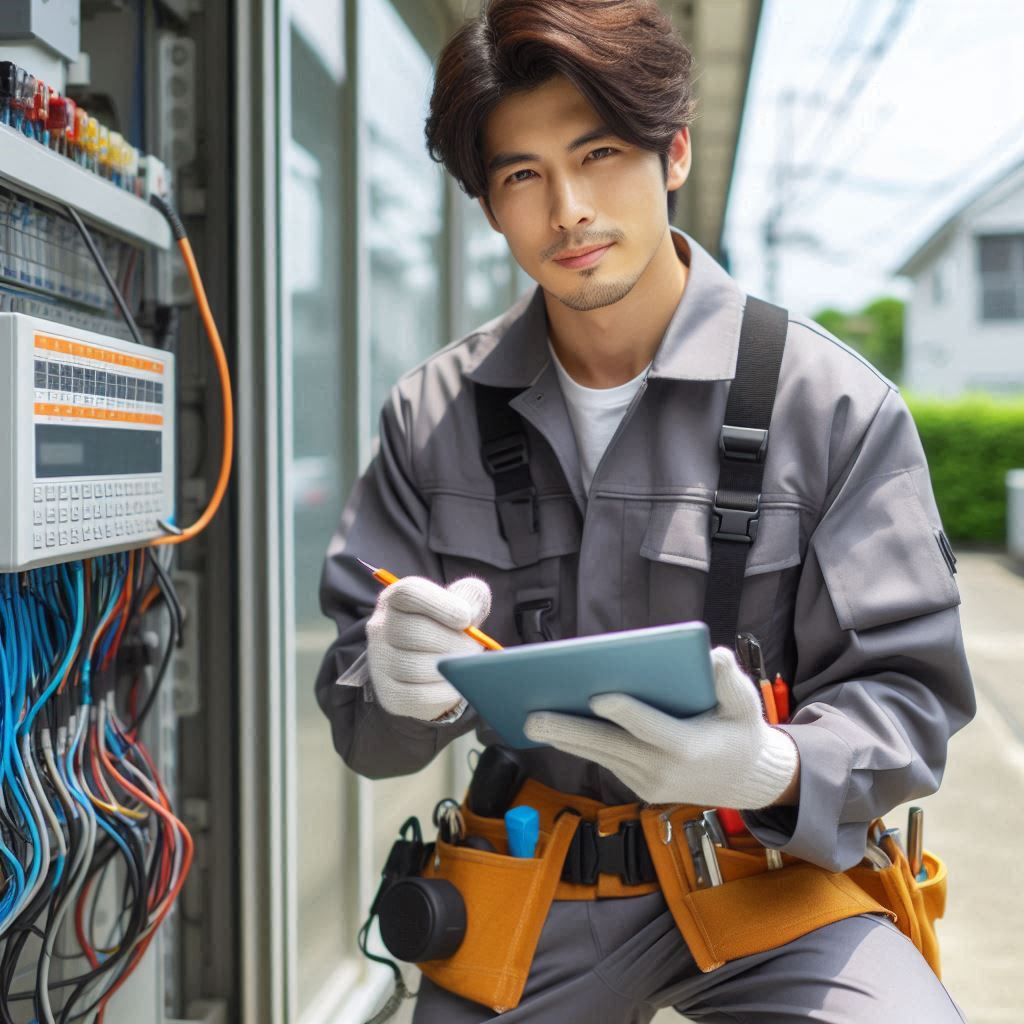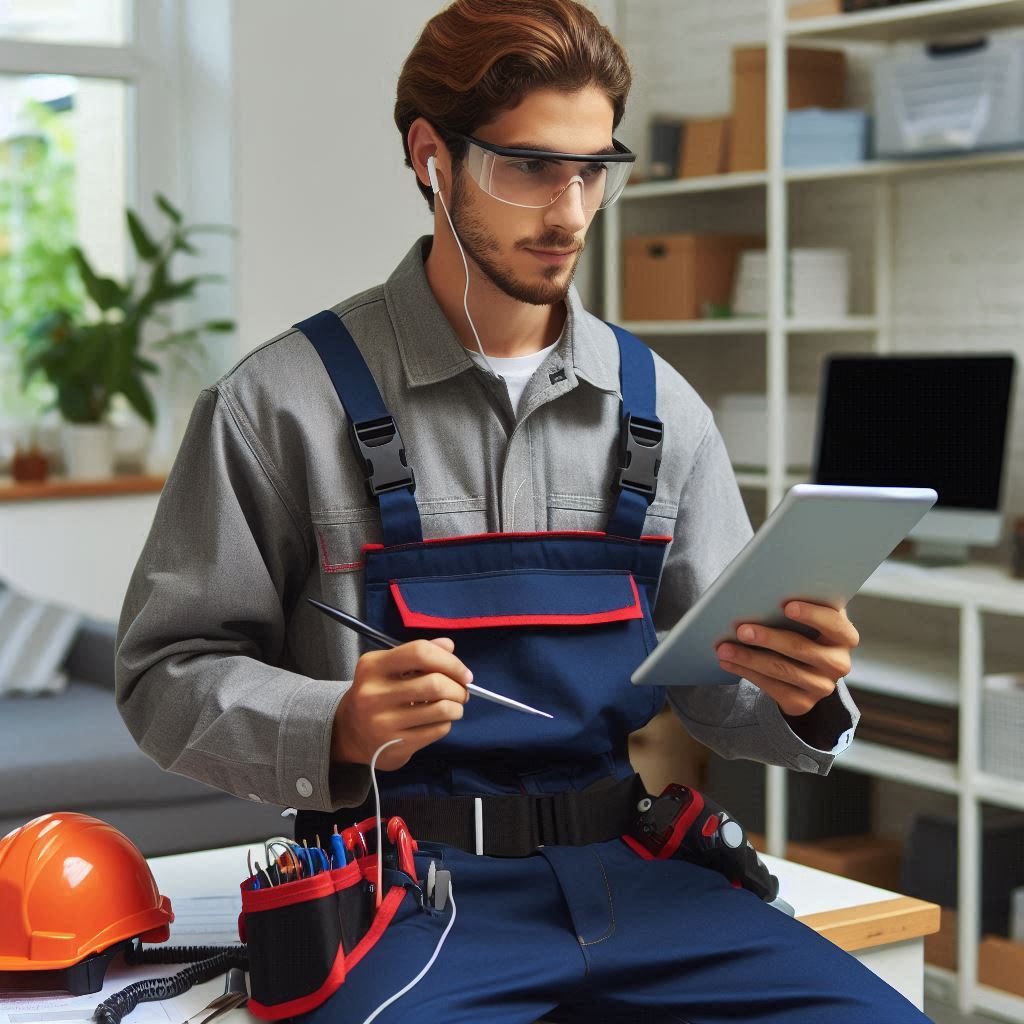Introduction
Field Service Technicians are vital in maintaining and repairing equipment across a broad range of industries.
They ensure that machinery operates smoothly, minimizing downtime and preventing costly disruptions.
Troubleshooting is a core skill for these professionals, requiring them to diagnose and resolve issues swiftly.
The importance of this skill cannot be overstated, as effective troubleshooting directly impacts customer satisfaction and operational efficiency.
Technicians often face various challenges in their work, such as dealing with complex and unfamiliar systems, limited access to detailed information, and the pressure of tight deadlines.
These challenges demand not only a deep understanding of the equipment but also the ability to think critically and adapt quickly to new situations.
As technology continues to evolve, the role of the Field Service Technician becomes increasingly complex, requiring continuous learning and skill development.
Troubleshooting remains at the heart of their responsibilities, making it an indispensable aspect of their profession.
Field Service Technicians must continually enhance their skills to keep up with evolving technology and equipment.
Understanding the basics of troubleshooting
What Troubleshooting Is and Why It Is Essential for Field Service Technicians
Troubleshooting is the process of identifying, diagnosing, and resolving problems or malfunctions in equipment or systems.
For Field Service Technicians, troubleshooting is a fundamental skill that affects their efficiency and effectiveness.
It allows them to pinpoint issues accurately, reducing downtime and improving service quality.
Effective troubleshooting helps ensure that equipment runs smoothly and meets customer expectations.
This skill is crucial for maintaining high standards of service and reliability in various technical fields.
Importance of Having a Systematic Approach to Troubleshooting Problems
A systematic approach to troubleshooting is vital for Field Service Technicians.
This methodical process involves following a clear set of steps to diagnose and solve problems.
It helps technicians avoid missing important details and jumping to incorrect conclusions.
By gathering information, analyzing symptoms, and testing solutions methodically, technicians can address issues more efficiently.
A structured approach ensures that all potential causes are considered and reduces the likelihood of errors.
This organized method not only speeds up the repair process but also improves the accuracy of solutions, leading to better service outcomes.
Examples of Common Issues That Field Service Technicians Encounter During Their Work
Field Service Technicians often face various common issues in their work.
Electrical malfunctions are frequent, including problems like tripped circuit breakers, faulty wiring, or issues with the power supply.
Mechanical failures are another common challenge, such as worn-out belts, broken motors, or jammed components.
Technicians also frequently encounter software glitches in modern equipment, which may require updates or reinstallations.
For instance, if an air conditioning unit isn‘t cooling properly, a technician might first check the thermostat settings, air filters, and electrical connections.
If these initial checks don‘t resolve the issue, they would then investigate deeper, such as examining the refrigerant levels or the compressor.
Similarly, when equipment fails to start, a technician might check if it‘s properly plugged in, inspect for blown fuses, or test the motor and control board.
Using a systematic troubleshooting approach allows technicians to efficiently diagnose and fix these issues, ensuring minimal disruption and maintaining high levels of customer satisfaction.
Read: Sustainable Wastewater Treatment Methods
Tips for Effective Troubleshooting
Importance of Gathering as Much Information as Possible Before Attempting to Troubleshoot a Problem
Gathering comprehensive information before diving into troubleshooting is fundamental to resolving issues effectively.
Begin by collecting all relevant details about the problem.
Ask the user for a clear description of the issue, including specific symptoms and any recent changes to the system.
Understanding the context in which the problem occurs is crucial; for instance, knowing whether the issue happens intermittently or continuously can provide significant clues.
Investigate any prior occurrences of similar issues and review the equipment‘s service history.
This information helps in narrowing down potential causes and directing your troubleshooting efforts more precisely.
Without adequate information, you risk misdiagnosing the problem, which can lead to wasted time and unnecessary repairs.
Using Tools Such as Multimeters, Diagnostic Software, and Manuals to Aid in the Troubleshooting Process
Utilizing appropriate tools is essential for effective troubleshooting.
Multimeters, diagnostic software, and manuals each play a critical role in diagnosing and resolving issues.
A multimeter is a versatile tool that measures voltage, current, and resistance.
It can help identify electrical problems by pinpointing faults in circuits and connections.
Diagnostic software, on the other hand, is invaluable for analyzing system performance and error codes.
This software can provide detailed insights into the condition of various system components, helping to locate faults that are not immediately visible.
Manuals are another indispensable resource.
They offer detailed information about the equipment‘s design, components, and standard troubleshooting procedures.
By consulting these manuals, you gain a deeper understanding of how the equipment should function and how to address specific issues.
Leveraging these tools effectively allows for a more accurate diagnosis and efficient problem resolution.
Starting with the Most Basic and Common Solutions Before Moving on to More Complex Troubleshooting Techniques
When troubleshooting, it‘s wise to start with the most basic and common solutions.
Simple issues often have straightforward fixes.
Begin by checking the most obvious factors, such as power sources, cables, and connections.
Ensure that all components are properly plugged in and that there are no loose or disconnected wires.
Verify that the equipment is powered on and configured correctly.
Many problems arise from simple mistakes or overlooked details, so addressing these first can often resolve the issue quickly.
If the basic checks do not resolve the problem, proceed to more complex troubleshooting techniques.
Systematically test individual components and use diagnostic tools to analyze more detailed aspects of the system.
This step-by-step approach helps in isolating the fault and avoids unnecessary disassembly or advanced testing before ensuring that basic issues have been ruled out.
Document each step of your troubleshooting process to keep track of what has been checked and to aid in further diagnostics or collaboration with colleagues.
By following this structured approach, you enhance your efficiency in diagnosing and resolving issues, ultimately leading to improved service quality and minimized downtime.
Communication skills
Significance of Effective Communication with Customers and Colleagues During Troubleshooting
Effective communication stands at the heart of successful troubleshooting for field service technicians.
When issues arise, clear and precise communication with both customers and colleagues is essential.
Misunderstandings can easily lead to delays, incorrect fixes, or even exacerbate the problem.
A technician who communicates effectively can quickly gather accurate information, diagnose issues correctly, and implement solutions efficiently.
This not only ensures a quicker resolution but also enhances customer satisfaction and trust.
When engaging with customers, it’s important to actively listen to their descriptions of the problem.
Allow them to express their concerns fully before jumping to conclusions.
This approach helps in capturing the complete picture of the issue.
Use reflective listening techniques to confirm your understanding, such as paraphrasing what the customer has said.
For example, ‘So, you‘re saying the machine started making a strange noise yesterday, and it hasn‘t worked properly since?‘
Effective communication with colleagues also plays a critical role.
When you need to involve others in troubleshooting, be thorough in sharing all relevant details.
This includes observations, customer feedback, and any steps already taken.
Collaborating with colleagues often brings fresh perspectives and additional problem-solving strategies that might not have been considered initially.
Clear and detailed communication among team members helps in aligning efforts and avoiding redundant or conflicting actions.
Importance of Asking the Right Questions to Gather Relevant Information About the Problem
Asking the right questions is fundamental in diagnosing and resolving technical issues.
The process begins with broad, open-ended questions to gather a general understanding of the problem.
For example, you might ask, ‘Can you describe what happened when the issue first appeared?‘ This type of question allows the customer to provide detailed information without being guided towards a specific answer.
Once you have a general sense of the issue, move on to more specific questions to narrow down the problem.
For instance, if a machine is malfunctioning, inquire about its last successful operation, any recent changes made to it, or if any warning lights were observed.
These specific questions help pinpoint the problem area more accurately and streamline the troubleshooting process.
Additionally, don‘t overlook the importance of asking about the environment in which the issue occurs.
Questions like ‘Has there been any recent change in the operating conditions?‘ or ‘Are there any other factors that might be contributing to the problem?‘ can uncover underlying causes that might not be immediately obvious.
This thorough questioning ensures that you gather all relevant information needed for an accurate diagnosis and effective solution.
Tips on How to Explain Technical Issues in a Clear and Understandable Manner to Non-Technical Individuals
Explaining technical issues to non-technical individuals requires a blend of simplicity and clarity.
Avoid using technical jargon that might confuse the customer.
Instead, use plain language and break down complex concepts into manageable parts.
For example, if a device isn‘t turning on, explain the issue in a step-by-step manner, ‘First, we‘ll check if the device is properly plugged into the power source.
Then, we‘ll see if the power source itself is working.‘
Analogies can be highly effective in making technical explanations more relatable.
For instance, compare a clogged filter in an HVAC system to a blocked drain in a sink.
This analogy helps the customer understand the issue in terms they are familiar with.
Use everyday objects or experiences to bridge the gap between technical concepts and everyday understanding.
Patience and empathy are also crucial when explaining technical issues.
Recognize that not everyone has a technical background and may feel frustrated or overwhelmed.
Approach each explanation with patience and a reassuring tone.
Regularly update the customer on your progress, explaining each step in a way that is easy to understand.
This keeps them informed and reduces anxiety about the troubleshooting process.
Basically, effective communication, asking the right questions, and explaining technical issues clearly are essential skills for field service technicians.
Mastering these techniques not only facilitates faster and more accurate problem resolution but also builds stronger relationships with customers and colleagues.
Read: Tips for Writing Environmental Engineering Reports
Time management
Importance of Efficient Time Management When Troubleshooting to Minimize Downtime for Customers
Efficient time management is crucial for field service technicians who strive to minimize customer downtime.
Downtime, whether planned or unplanned, can significantly disrupt business operations and affect customer satisfaction.
Technicians who manage their time effectively can resolve issues faster, leading to reduced downtime and improved customer experiences.
By prioritizing tasks and addressing critical problems promptly, technicians can ensure that customers face fewer disruptions.
Transform Your Career Today
Unlock a personalized career strategy that drives real results. Get tailored advice and a roadmap designed just for you.
Start NowEffective time management goes beyond just completing tasks quickly.
It involves strategic planning, organization, and the ability to adapt to changing circumstances.
Technicians who manage their time well are better equipped to handle unexpected issues and still meet their service commitments.
This proactive approach not only prevents minor issues from escalating but also builds a reputation for reliability and efficiency.
Strategies for Prioritizing Tasks and Identifying Critical Issues That Need Immediate Attention
To manage time effectively, technicians must prioritize tasks and identify critical issues that require immediate attention.
Start by assessing the impact of each problem on the customer‘s operations.
Issues that halt productivity or affect essential functions should be addressed first.
For instance, if a machine breakdown halts a production line, it becomes a priority over less urgent issues.
A useful strategy is to categorize issues based on their urgency and impact.
High-priority tasks are those that pose immediate risks or significant disruptions.
Medium-priority tasks are important but do not halt operations entirely, while low-priority tasks can be addressed later.
This categorization helps technicians focus their efforts where they are needed most and ensures that critical issues are resolved swiftly.
Communication is also key in prioritizing tasks. Discuss with customers to understand their immediate needs and expectations.
Clear communication helps in setting realistic timelines and managing expectations.
It also allows technicians to align their efforts with the customer‘s priorities, leading to more effective service delivery.
Suggest Creating a Timeline or Checklist to Stay Organized and Focused During Troubleshooting
Creating a timeline or checklist is a practical approach to staying organized and focused during troubleshooting.
Start by developing a detailed checklist of all tasks and steps involved in resolving the issue.
This checklist should include every action that needs to be taken, from initial diagnostics to final repairs.
A well-structured checklist helps ensure that no step is overlooked and provides a clear path to follow.
A timeline complements the checklist by assigning specific time frames to each task.
Estimating how long each task will take helps in managing time effectively and ensures that the overall troubleshooting process remains on track.
Be realistic about the time required and factor in potential delays or complications.
Adjust the timeline as needed based on actual progress and any unforeseen issues.
Regularly update the checklist and timeline as tasks are completed.
This practice prevents confusion and keeps the troubleshooting process on course.
A checklist also serves as a visual reminder, helping technicians stay focused and organized.
By following a timeline, technicians can better manage their workload and ensure that each task is completed in a timely manner.
Therefore, efficient time management, effective task prioritization, and organized planning are essential for minimizing customer downtime.
By implementing these strategies, field service technicians can enhance their service delivery, improve customer satisfaction, and achieve better overall results.
Read: How to Stay Updated in Environmental Engineering Field

Explore Further: Telecommunications Technician: Tools and Equipment Checklist
Continuous learning and improvement
Field Service Technicians to Stay Up-to-Date with New Technologies and Troubleshooting Techniques
Field Service Technicians must consistently stay up-to-date with new technologies and troubleshooting techniques.
The technological landscape is ever-changing, with equipment and software evolving at a rapid pace.
As new tools and systems emerge, technicians who remain informed about the latest advancements will be better equipped to handle complex problems.
This knowledge enables them to use cutting-edge tools and adopt the most effective troubleshooting strategies, ensuring they provide high-quality service.
Keeping abreast of technological changes also helps technicians stay competitive in their field.
Technicians who are proactive about learning and adapting to new developments will be more efficient and effective in their roles.
Staying updated not only improves their problem-solving capabilities but also enhances their ability to address a broader range of issues, ultimately benefiting their clients and employers.
Attending Training Sessions, Workshops, and Conferences to Enhance Troubleshooting Skills
To enhance troubleshooting skills, Field Service Technicians should regularly attend training sessions, workshops, and conferences.
These educational events are invaluable for keeping up with industry advancements and acquiring new techniques.
Training sessions often focus on specific technologies or problems, providing hands-on experience that helps technicians learn the latest methods and tools.
Workshops offer an opportunity for in-depth exploration of particular skills or issues, allowing technicians to practice and refine their techniques.
Conferences, on the other hand, expose technicians to the latest trends and innovations in their field.
They offer a platform to learn from industry leaders, network with peers, and gain insights into emerging technologies.
Participating in these events fosters continuous learning and professional growth.
Technicians who engage in ongoing education will enhance their troubleshooting abilities and maintain their edge in a rapidly evolving industry.
Importance of Learning from Past Experiences and Seeking Feedback from Colleagues
Learning from past experiences is a crucial aspect of refining troubleshooting skills.
Each repair or service call provides valuable lessons that can improve future performance.
Technicians should take the time to review and analyze previous cases to understand what strategies were effective and what could be improved.
This reflective practice helps in identifying patterns and recurring issues, which can inform better approaches to problem-solving.
Additionally, seeking feedback from colleagues is essential for professional development.
Collaborating with peers and discussing challenges and solutions can provide new perspectives and innovative techniques.
Constructive feedback helps technicians recognize their strengths and areas needing improvement, allowing them to address weaknesses and build on their successes.
By combining insights from past experiences with feedback from others, technicians can continually enhance their troubleshooting skills and provide superior service.
This approach not only boosts their confidence but also ensures they are well-prepared to handle a wide range of issues effectively.
Read: Environmental Engineering and Corporate Social Responsibility
Find Out More: Best Online Courses for Aspiring Drafters
Handling difficult situations
Tips on How to Remain Calm and Composed When Faced with Challenging or Stressful Troubleshooting Scenarios
Maintaining calm and composure during stressful troubleshooting scenarios is crucial for effective problem-solving.
Start by taking deep breaths to manage your stress levels.
Focus on the task at hand and avoid letting frustration overwhelm you.
Break down the problem into smaller, manageable parts to simplify your approach.
Stay organized and methodical in your troubleshooting process.
Avoid jumping to conclusions or making hasty decisions.
Taking a short break can also help clear your mind and reduce anxiety.
Remember, staying calm allows you to think more clearly and make better decisions, which leads to more effective troubleshooting.
Recommend Seeking Assistance from Senior Technicians or Supervisors When Encountering Complex Problems
When faced with complex problems, don‘t hesitate to seek assistance from senior technicians or supervisors.
Experienced professionals can offer valuable insights and alternative approaches.
Their expertise often helps in identifying issues that may not be immediately apparent.
Collaborating with more knowledgeable colleagues can also speed up the troubleshooting process.
If you‘re stuck, asking for help demonstrates a proactive approach rather than a lack of skill.
Senior technicians and supervisors can provide guidance, suggest additional diagnostic tools, or share similar experiences.
Leveraging their knowledge ensures that complex problems are addressed more efficiently and accurately.
Importance of Patience, Perseverance, and Problem-Solving Skills in Overcoming Difficult Troubleshooting Situations
Patience and perseverance are key traits in overcoming difficult troubleshooting scenarios.
Some problems require time and detailed investigation to resolve.
Avoid rushing through the process, as it can lead to mistakes and overlooked details.
Stay persistent and methodical, and don‘t give up when solutions are not immediately apparent.
Problem-solving skills are crucial for navigating complex issues.
Approach each challenge with a logical mindset and use systematic methods to identify the root cause.
By staying patient and applying strong problem-solving techniques, you can effectively tackle even the most challenging problems.
Combining these traits with a calm demeanor and collaborative support will enhance your ability to overcome difficult troubleshooting situations.
Uncover the Details: The Importance of Research in Transportation Engineering
Explore Further: Global Opportunities for Geotechnical Engineers
Transform Your Career Today
Unlock a personalized career strategy that drives real results. Get tailored advice and a roadmap designed just for you.
Start NowConclusion
Troubleshooting skills are crucial for Field Service Technicians.
These skills enable technicians to identify and resolve issues effectively.
By following the tips and strategies mentioned in this blog post, readers can enhance their troubleshooting abilities and excel in their profession.
It is important for technicians to stay updated with the latest tools and technologies, as this will help them troubleshoot more efficiently.
Effective communication with customers is also key in resolving issues promptly.
Additionally, documenting the troubleshooting process can aid in future problem-solving.
Regular training and practice can further sharpen troubleshooting skills.
Field Service Technicians play a vital role in maintaining customer satisfaction and ensuring the smooth operation of equipment.
Therefore, mastering troubleshooting techniques is essential for success in this field.
By implementing the tips discussed in this post, technicians can improve their troubleshooting skills and become more proficient in their roles.
Overall, continuous learning and development are essential for Field Service Technicians to stay ahead in their profession and provide excellent service to their customers.




